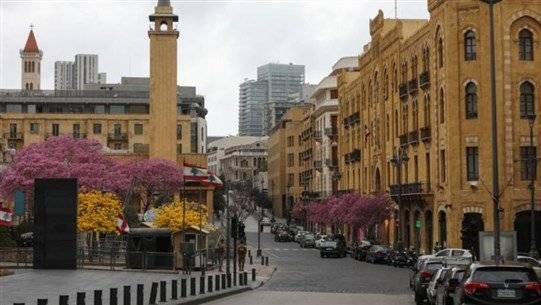Central Beirut closely resembles the general state of Lebanon. This area has turned into a ghost town, especially in the past two years, marked by the erection of tall concrete walls to keep protesters away from the Parliament building. Most shops have closed, and many have suffered from vandalism and destruction. Today, efforts are underway to revive it, albeit slowly and cautiously... yet it seems there is no life for those who call.
On May 26, the last concrete barrier was removed from the entrances to Martyrs' Square, where the Parliament building is located. This followed various pressures leading up to the first session of the new Parliament, especially as several individuals who participated in the protests against the "political system" became deputies. Thus, isolating the Parliament building from its surroundings was no longer effective. However, it appears that trust between the people and the officials is still missing. Instead of the removal of the walls resulting in citizens flocking to Martyrs' Square, which was once a popular tourist destination, concrete barriers have been replaced with "lighter" iron ones. Access to the area for non-workers is prohibited. When we asked a security personnel guarding one of the entrances whether access was allowed, he said, "The area is still closed to the public. There are some works in a few restaurants, but they are in their initial stages. The area may be reopened in the coming weeks, but it is currently closed."
Movement in the side streets leading to Martyrs' Square is completely absent. These streets, which host numerous restaurants, seem resigned, as if they were a warrior who laid down his weapon years ago and has no intention of fighting again.
Since the assassination of former Prime Minister Rafik Hariri in 2005, paralysis has seeped into Central Beirut, and with the successive events that the country has experienced, the activity has dwindled. Many investors and shop owners quickly surrendered, closing their establishments and leaving. Others chose to "resist" and remained, only to be forced out by the protests on October 17, 2019, which saw violence exerted by security forces against demonstrators, turning the streets of Central Beirut into a battlefield. Many protesters resorted to vandalism to express their outrage, affecting both public and private properties. What was not destroyed by them faced severe damage due to the Beirut Port explosion in August 2020. The ongoing financial collapse and banks withholding depositors' funds further deepened the crisis in "Central Beirut" and for its business owners.
In the upper part of the area, the colorful slogan "I Love Beirut" still stands, absent of the tourists who used to gather around it to take photos. In the commercial market, where hundreds of shops exist, only about 10 are still open, with their owners counting on a tourist season that stakeholders believe will thrive, anticipating over a million tourists by September.
The Ministry of Tourism closely monitors the situation in Central Beirut as part of its efforts to revitalize the area as a key tourist destination in the country, similar to all countries worldwide. Minister of Tourism Walid Nassar points out that the reopening of streets still closed is being followed up by the relevant ministries, specifically the Ministry of Interior, which coordinates with the security of the Parliament. He considers that reopening markets and shops requires time and trust. Nassar stated in a press interview: "As part of our efforts to revive the area, we plan to hold a full week of festivals, moving all international festivals from various regions to be held in the heart of the capital, dedicating a side street for each festival, to take place by the end of July at the latest." When asked who holds responsibility for the death of the city center, he replied: "The death of Beirut is the responsibility of those who closed, broke, and burned the city and violated public and private properties."
Many slogans calling for the overthrow of the "regime" and its pillars, written by protestors two years ago on the walls of buildings surrounding the Parliament, remain visible even after the majority have been removed.
The situation in the area differs between day and night. The timid activity in the morning and afternoon gradually disappears as night falls, rendering the "center" once again a "ghost town," especially amidst continuous electricity cuts.
Nicolas Shammas, head of the Beirut Traders Association, links the return of life to this area with providing trust and reassurance for visitors and consumers, stating, "The fewer obstacles and barricades we have, the better the psychological effect on visitors." Shammas noted in a press statement that "the area can be divided into two parts; the upper side, where the banks street, Riad el-Solh Square, and Martyrs' Square are located, has been very bad for about 17 years, with all commercial shops closed and the area abandoned. The lower section is slightly better, where of 7 shops, one or two are still open." He added, "However, if there is a dead part of the area, that automatically extends to other parts." Shammas emphasizes that "revitalizing Central Beirut again cannot be done at the push of a button. It may take one or two tourist seasons, as if there are good numbers of visitors to the area this season, it will encourage traders to reopen their establishments." He reminds us that rents are very high, so no one will risk returning without assurance of guaranteed returns.




